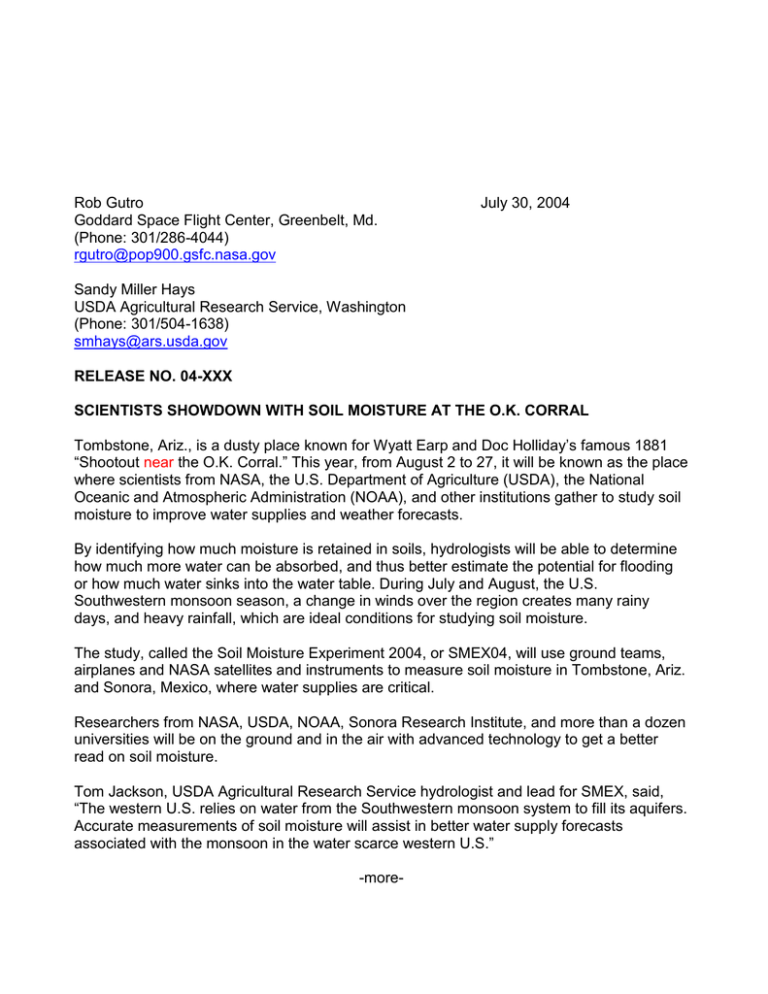Rob Gutro July 30, 2004 Goddard Space Flight Center, Greenbelt, Md.
advertisement

Rob Gutro Goddard Space Flight Center, Greenbelt, Md. (Phone: 301/286-4044) rgutro@pop900.gsfc.nasa.gov July 30, 2004 Sandy Miller Hays USDA Agricultural Research Service, Washington (Phone: 301/504-1638) smhays@ars.usda.gov RELEASE NO. 04-XXX SCIENTISTS SHOWDOWN WITH SOIL MOISTURE AT THE O.K. CORRAL Tombstone, Ariz., is a dusty place known for Wyatt Earp and Doc Holliday’s famous 1881 “Shootout near the O.K. Corral.” This year, from August 2 to 27, it will be known as the place where scientists from NASA, the U.S. Department of Agriculture (USDA), the National Oceanic and Atmospheric Administration (NOAA), and other institutions gather to study soil moisture to improve water supplies and weather forecasts. By identifying how much moisture is retained in soils, hydrologists will be able to determine how much more water can be absorbed, and thus better estimate the potential for flooding or how much water sinks into the water table. During July and August, the U.S. Southwestern monsoon season, a change in winds over the region creates many rainy days, and heavy rainfall, which are ideal conditions for studying soil moisture. The study, called the Soil Moisture Experiment 2004, or SMEX04, will use ground teams, airplanes and NASA satellites and instruments to measure soil moisture in Tombstone, Ariz. and Sonora, Mexico, where water supplies are critical. Researchers from NASA, USDA, NOAA, Sonora Research Institute, and more than a dozen universities will be on the ground and in the air with advanced technology to get a better read on soil moisture. Tom Jackson, USDA Agricultural Research Service hydrologist and lead for SMEX, said, “The western U.S. relies on water from the Southwestern monsoon system to fill its aquifers. Accurate measurements of soil moisture will assist in better water supply forecasts associated with the monsoon in the water scarce western U.S.” -more- -2SMEX scientists want to know what atmospheric conditions create long-lasting rainfalls over a large area. By knowing which factors create large or small rainfall, hydrologists can provide better forecasts and know how much water will be available to people. From space, NASA’s Aqua, Terra and QuikScat satellites will provide various measurements. Aqua’s Advanced Microwave Scanning Radiometer (AMSR-E) instrument will measure soil moisture, Terra’s Moderate Resolution Spectroradiometer (MODIS) will provide vegetation status and Terra’s Advanced Spaceborne Thermal Emission and Reflection Radiometer (ASTER) will measure the surface temperature. The SeaWinds instrument on the QuikScat satellite will observe the monsoon winds that bring in the moisture from the Pacific Ocean to the U.S. Southwest. Closer to Earth, the Naval Research Laboratory P-3 aircraft will fly over the areas and use microwave radiometers to measure soil moisture. Radiometers measure soil moisture by detecting the electrical properties of the water. Meanwhile on the ground, scientists will use instruments to tell them the temperature and percentage of moisture in soils from 2 to 40 inches deep. The satellite, airplane and ground data will all be compared. Scientists will then be able to validate that soil moisture can be estimated from space-based instruments. These observations will be input into computer models to re-create conditions researchers see in the field. “By re-creating these conditions, scientists will be able to better understand how the land surface and soil moisture affect the way the atmosphere responds,” said Peggy O’Neill, physical scientist at NASA’s Goddard Space Flight Center, Greenbelt, Md. The SMEX04 mission is part of the larger North American Monsoon Experiment (NAME), led by NOAA, which is dedicated to understanding how the Southwestern U.S. monsoon season works. This monsoon is characterized by a wind pattern shift that exerts a strong influence on precipitation and temperatures across the western United States, Mexico, and adjacent ocean areas. Monsoons need to be accurately understood and predicted by weather and climate models, because their influence on seasonal weather, including floods and droughts, can significantly disrupt regional economies and populations. NASA's Earth Science Enterprise is dedicated to understanding the Earth as an integrated system and applying Earth System Science to improve prediction of climate, weather and natural hazards using the unique vantage point of space. For more information and images, please visit on the Internet: http://www.gsfc.nasa.gov/topstory/2004/0729soilshowdown.html For more information on the SMEX Experiment, please visit on the Internet: http://hydrolab.arsusda.gov/smex04/ -end-







